
Chinese ribbon microphone buyer’s guide
Saturday, November 1st, 2008 | by Michael Joly
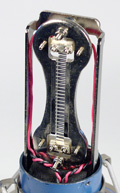 What’s the difference between various inexpensive made-in-China ribbon mics? There are so many styles, makes and models!
What’s the difference between various inexpensive made-in-China ribbon mics? There are so many styles, makes and models!
Importers and “rebranders” of made-in-China mics often specify different body, headbasket and color schemes to differentiate their microphones from other brands. But just as the capsule is the heart of a condenser microphone, the “motor” is the heart of a ribbon mic.
As it turns out, there are really just a small number of ribbon motor types hiding within the headbaskets of all these mics. Once recordists know which ribbon motor lives within a particular microphone, they can predict how a mic will sound — and how it compares to others in the inexpensive-ribbon-mic category.
Editor’s Note, 2010
This article was written to “lift the hood” from Chinese ribbon microphones, to reveal that just three basic ribbon motor designs — and three characteristic sound profiles — underlie the dozens of different makes and models of imported ribbon microphones.
In that context, Michael Joly’s original simplification of “long ribbon” vs “short ribbon” was descriptive and useful.
In the broader historical context of older, European ribbon-microphone designs, though, the terminology we selected caused some confusion, because numerous older microphones employ ribbon elements significantly shorter than the so-called “short ribbon” designs presented here. See, for example, the Beyerdynamic M-130.
For this reason, we have updated the article with new terminology. The ribbon motor designs formerly described here as “short ribbon” have been renamed “medium ribbon.”
Technically-minded readers will notice that the “short path” ribbon motor design illustrated below is actually a variable-length path, due to the hourglass shape of the housing. The audio effects of this structure are complex, and are beyond the scope of this introductory article. With an apology to readers who correctly point out this oversimplification, we have left the “short path” terminology in place.
Over the past several years, every type of made-in-China ribbon mic has come across my bench for modification. Here are my notes about the similarities and differences between the ribbon motors found inside.
“Long Ribbon / Short path” Ribbon Motor Mics
Representative mics include:
These models, the first made-in-China mics available in the West, are essentially the same mic with different cosmetic finishes. The ribbon motor bears an uncanny resemblance to the motor found in the $1000 AEA R84.
This motor features a long (55mm) aluminum ribbon suspended between two thin Neodymium magnets attached to an hourglass-shaped yoke. The yoke tapers to minimum width at the center of the magnets to allow the shortest front-to-back acoustic path length possible. The distance audio would travel from the front of the ribbon around the magnets and yoke to the back determines the on-axis, downward shelving frequency (high-frequency rolloff point) in these ribbon microphones. As noted in the BBC Engineering Division’s Monograph 4, The Design of a Ribbon Type Pressure Gradient Microphone (D.E.L. Shorter and H.D. Harwood, December, 1955):
Shorter & Harwood
[T]he acoustic obstruction created by the permanent magnet and its junction with the pole-pieces produced some deterioration in frequency response… There are in effect two external paths between front and back of ribbon, namely, the short distance around the pole pieces and the long distance round the magnet. The length of the latter path … [gives] a low cut-off frequency; above this frequency … the microphone response falls to a level which depends on the distance around the pole pieces.
Ribbon length affects frequency response as well. All other factors being equal, the longer a ribbon is, the sooner the vertical off-axis response will fall off. In other words, a longer ribbon has less extended HF response in the vertical off-axis compared to a shorter ribbon.
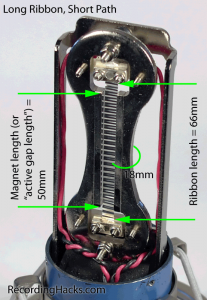 I have taken to calling the motor type described above as a “long ribbon / short path” design, as a shorthand way of describing its construction and frequency response characteristics.
I have taken to calling the motor type described above as a “long ribbon / short path” design, as a shorthand way of describing its construction and frequency response characteristics.
These first-to-market Chinese ribbon mics have a very shallow and wide ribbon corrugation pattern. This corrugation pattern tends to provide less than ideal ribbon movement control, and has been observed to lose tension over time, resulting in lowered resonant frequency. The ribbon corrugation pattern was improved in subsequent models (described below).
The large headbasket on these first-generation mics is certainly visually impressive. It reminds me of the early days of radio, with Frank Sinatra or Bing Crosby crooning coast-to-coast in front of an RCA-44BX. Unlike the 44BX, the large headbaskets on these inexpensive imports have severe mechanical resonance modes — when tapped or excited by percussive sounds, they ring. This headbasket-induced resonance can lend a metallic or ringing haze to otherwise pure audio.
Another distinguishing feature of these large headbasket mics is the use of a nylon-covered wire mesh box for wind blast protection. While the mesh is very successful at protecting the ribbon from strong gusts of wind, there is a downside: the fabric/wire box is actually a bandpass filter. Like all analog bandpass filters, this blast filter imparts phase shifts in the audio band. Most noticeably, the high pass portion of the filter imparts a phase shift in the bass region. The result is a degradation of time alignment across the lower audio band.
The second effect of this mesh is a low-pass function caused by layers of fabric — an attenuation of high frequency audio.
The Second Generation
Representative mics include:
These second-generation models use the same ribbon motor design (“long ribbon / short path”) as the mics above, but feature improved headbaskets with reduced mechanical resonance.
The smaller headbasket necessitated the elimination of the fabric-and-wire-box wind blast filter found in the larger models. However, both the large- and small-headbasket mics make use of fabric-covered, perforated “waffle plates” as a combined wind blast filter and high frequency resonator. While these plates do provide protection from wind gusts, and offer a couple dB of high frequency boost, they also create a parallel reflection zone that degrades time-domain performance of the ribbon motor and imparts high frequency comb filter effects.
A final difference between the first and second-generation ribbon mics described here is that the newer mics’ ribbon corrugation pattern is both narrow and deeper, which leads to greater control of ribbon movement.
So here we have eight mics, all with the same “long ribbon / short path” ribbon motor! These mics all exhibit extended high-frequency response on-axis (usable to 16 kHz), extended high frequency response off-axis in the horizontal plane and somewhat diminished high frequency response off-axis in the vertical plane. For these reasons, the “long ribbon / short path” mics are popular where wide, smooth frequency response is desired: vocals, acoustic guitar or piano, for example.
“Medium Ribbon / Long Path” Ribbon Motor Mics
Representative mics include:
A couple of years after the original made-in-China ribbon mics began to lose some of their luster, the vendors began to offer a second category of ribbon motor that allowed rebranders to introduce more compact mic designs. Compared to the “long ribbon / short path” mics, the microphone models named above all feature a shorter (45mm) aluminum ribbon suspended between two somewhat thicker Neodymium magnets attached to a yoke with straight sides.
The thicker magnets allow greater magnetic force to be concentrated on the ribbon, and thus make up for some sensitivity loss due to the shorter length of ribbon exposed to the magnet flux. However, the thicker magnets and straight-sided yokes increased the critical front-to-back acoustic path length and thus move the downward shelf to a lower frequency (8 kHz) than what is found in the “long ribbon / short path” motors described above.
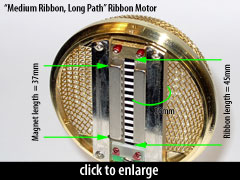 These mics also typically exhibit a mild “peak-before-cut” frequency response shape in the upper midrange. Subjectively, these mics have greater upper midrange presence and reduced apparent high frequency extension than the “long ribbon / short path” mics. For this reason, the “medium ribbon / long path” mics are popular as guitar cab and drum overhead applications where the recordist wants to attenuate high frequency energy that can become unpleasant, such as bad-sounding electric guitar distortion or cymbal hash, yet still allow the important midrange source material to cut through.
These mics also typically exhibit a mild “peak-before-cut” frequency response shape in the upper midrange. Subjectively, these mics have greater upper midrange presence and reduced apparent high frequency extension than the “long ribbon / short path” mics. For this reason, the “medium ribbon / long path” mics are popular as guitar cab and drum overhead applications where the recordist wants to attenuate high frequency energy that can become unpleasant, such as bad-sounding electric guitar distortion or cymbal hash, yet still allow the important midrange source material to cut through.
“Dual Medium Ribbon” Mics
One of the challenges of recording with ribbon mics is their lower sensitivity when compared to condenser types. In an effort to get a bit more “umph” out of ribbon mics, the Chinese vendors turned to an old technique — the dual-ribbon motor. Two ribbons are used, each suspended in its own magnetic gap. All things being equal, output level is increased; quieter sources can be recorded without needing quite as much preamp gain.
The mics mentioned above use the familiar “medium ribbon / long path” motor, but magnets are arranged to create two gaps into which two aluminum ribbons are mounted. Because of slight manufacturing variances, each ribbon is tuned to a slightly different fundamental resonant frequency. When ribbon signals are summed together electrically this produces a complex sum & difference signal that lends these mics a “thicker” but somewhat less true-to-life sound.
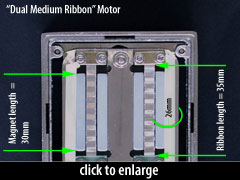 This mic type has the shortest ribbon length of the three Chinese motors and thus has the most extended high frequency response off-axis in the vertical plane.
This mic type has the shortest ribbon length of the three Chinese motors and thus has the most extended high frequency response off-axis in the vertical plane.
Headbasket Sizes and Shapes
This article has focused on the similarities and differences between ribbon motors in some of the more common made-in-China ribbon mics. But headbasket shapes and sizes play a role in the sound of ribbon mics as well.
Just cup your hands around your mouth and speak, then open and close the “cup” around your mouth. You’ll hear a change in the complex resonance created by the size and shape of your hands cupped around your mouth.
Similarly, but thankfully not as dramatically, the same effect occurs when a wire mesh (or perforated metal) headbasket is installed around a microphone transducer. The particular size and shape of the various reflecting surfaces of the headbasket conspire to create a complex “acoustic signature” that is then transduced into electrical energy by the ribbon motor.
Summary
To review, there are only three basic Chinese ribbon motors:
- “Long Ribbon / Short Path”
- “Medium Ribbon / Long Path”
- “Dual Medium Ribbon / Long Path”
These three ribbon motors yield three basic sound profiles:
- flat, extended frequency response
- midrange boost with high frequency attenuation
- thicker mid boost with high frequency rolloff
The addition of subtly different headbasket shapes and sizes add an element of sonic individuality to each unique made-in-China ribbon mic model.
When building a collection of inexpensive ribbon mics, start by covering all three basic ribbon motor types, then experiment within the three ribbon motor categories by trying out various headbasket designs to explore subtle flavor shadings.
Ribbon motor measurements
| Dimension | Long Ribbon/Short Path | Medium Ribbon/Long Path | Dual Ribbon |
|---|---|---|---|
| magnet length | 50mm | 37mm | 30mm |
| ribbon length | 66mm | 45mm | 35mm |
| audio path distance around yoke | 18mm | 36mm | 26mm (one way) |
Tags: apex, avant, bbc, cad, cascade, nady, ribbon, shinybox
Posted in Microphones | 39 Comments »
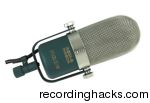
















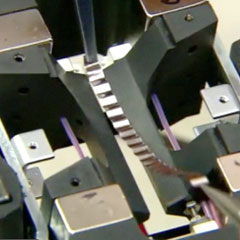

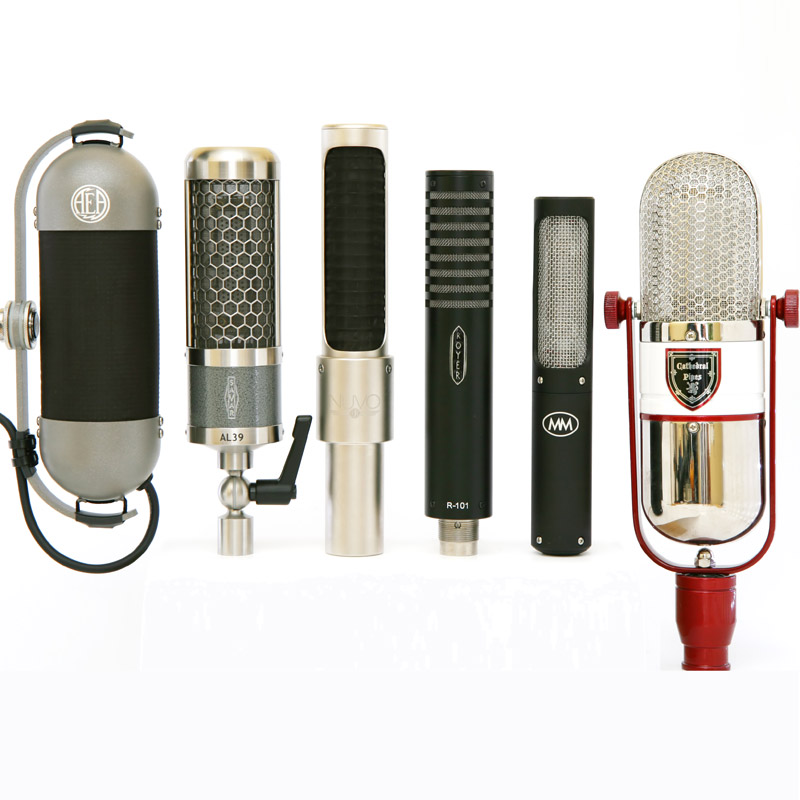
Michel.
November 3rd, 2008 at 6:55 am
Wow, Thanks for this great article. This has to be the greatest to the point article about mics I have seen and the best about ribbons also!
Michel.
Nestor
November 3rd, 2008 at 1:10 pm
Wow ! never saw something like this, just for nwbiz , kinda instructional, inspirational and recreational !
Why not a crashcourse about ribbon microphones ?
Always considered a ‘ Noimann’ (intended typo) the top mike for vocals but was before this.
Nestor (ARG)
Greek origin name pronn. as in ‘next store’ 🙂
Will Chen
November 6th, 2008 at 5:53 am
Absolutely excellent article, thank you so much. I recently picked up my first ribbon, an APEX 210, and am having a bunch of fun with it. This article will certainly be of help to more inexperienced engineers or those on a tight budget.
Frans van den Berge
November 28th, 2008 at 6:40 am
I do miss the Superlux R102 microphone wich is a new type of ribbon as far as I am aware.
I do use Superlux microphones extensively and have not been disapointed with them. I do have several other brands for comparison.
JWL
November 29th, 2008 at 10:05 am
Michael, as always your intellectual generosity is most appreciated. Great article!
Bill Kahler
November 29th, 2008 at 6:35 pm
Interesting stuff Michael and thanks for the post on my blog. Also glad to find out about your blog too. Interesting to hear the mechanics behind why the Cascade mics work so well for certain applications and why sometimes I just go for one of mt LDC mics. They work well when I’m going for an “old fashioned” sax sound, really good on a harsh trumpet, nice when recording three acoustic players in a circle – null points eliminate a lot of the bleed. Also had great luck recording rock guitar stuff.
What a blast! Look forward to reading more of your stuff – take care. Bill
Paul
November 30th, 2008 at 7:56 pm
Thanks for a great, informative article. One thing I noticed you didn’t mention is the transformers. While I know a lot of people replace the stock transformers with Cinemag and Lundahl transformers, I’d still be interested to know what differences there are between the stock transformers in different brands/models.
Joseph Bulger
December 11th, 2008 at 8:56 am
Hi,Mike,Do you know if any of these mics can be used or modified to measue out to 50khz?I am looking to measure the frequeny response of a pair of plasma tweeters and ribbon tweeters that me and a friend made for high end audio.We are looking to measure for mainly 5kz to 50 khz.Do you have any suggestions?I cannot afford the earthworks mics.Thanks,Joe.
michael joly
December 11th, 2008 at 11:59 am
Re: Measurement mics –
Rather than a ribbon mic, I’d suggest you look into the various 1/4″ electret capsule made by Panasonic or Transound for which there is published frequency resposne data, research and perform the “Linkwitz mod” on them and use them feed a wide bandwidth preamp / analysis system.
John
December 29th, 2008 at 5:53 pm
Hi Michael,
Great info!
I am looking for a low cost Mic that sounds as close to the RCA 44BX as possible.
What would you suggest?
kimblez
January 1st, 2009 at 2:51 am
thank you for this excellent info, out of the different brands of chinese ribbons mics….are there any that you reccomend for best sound quality in their particulair catagory,or is there a style out of the 3 you mentioned that you favor soundwise?
Bryan
January 19th, 2009 at 8:38 am
Re: RCA 44BX
The Bang & Olufsen BM-3 with NOS RCA ribbon by Steven Sank is about as close to an RCA44 that you’re going to get. They sell them at proaudioheaven.com for about $750, but you might get one on ebay for considerably cheaper and send it to them for a re-ribbon.
Gary
February 12th, 2009 at 2:15 pm
One well written article!
Thanks for the info.
Gary SC59
April 4th, 2009 at 5:01 pm
Great info, helped me decide. I had an Apex 210. I read things about magnets deteriorating, but it is probably not a valid concern. The mic will likely outlive me. I am tempted to try the 205 for acoustic. THANK YOU!
Jim Devlin
May 4th, 2009 at 5:18 am
Great Article,
What I was really waiting for was the value comment. When compared to what these mics are copying, how do they stand up? Do you think they are a fair, good, great or fantastic value?
What would you rate them out of 10 comparing them to the real thing?
Thanks,
Jim
John Judge
July 4th, 2009 at 8:28 pm
Hello,
I just ran across the web site and have booked marked it, some great info here!
I just got a RSM-4 and have heard about the ribbon being slack on them. The test is to turn the face of the mic slowly back & forth facing the floor and to listen for a “klunk”. I THINK I hear it, but am unsure. The pic of the internealss of the round headed ribbon looks like the RSM-4, and if so, I see no way to tightn the ribbon.
Is this even possible by the owner, or should it be sent into some one? Thanks for any info anyone can toss my way, and again, Great Site!
matthew mcglynn
July 4th, 2009 at 8:33 pm
John – most ribbons are fragile. I personally wouldn’t try to retension one, but you’re certainly welcome to. The worst thing that could happen is that you rip it and have to send it to someone to be repaired. The benefit of having a professional do it (whether or not you’ve ripped the stock one first) is that they’ll use a higher-grade ribbon material that will likely sound better. Consider a transformer upgrade too. Good luck.
John Judge
July 7th, 2009 at 10:31 pm
Thank You for the info!
And I don’t have a clue what happened with my first message, I don’t type THAT bad! 🙂
David Lussier
August 6th, 2009 at 3:16 am
Great article. It goes back to my philosophy that it is important to know who makes what, in terms of big online retailers and the rebranding of gear. It’s always important to do your home work before opening the wallet.
ephemeral mists
August 23rd, 2009 at 3:28 pm
Thanks for this excellent article. I was looking for more info on the vin-jet so this article was a treat!
Fix My Ribbon Mic Jones « littlepear and the big adventure
October 8th, 2009 at 11:19 pm
[…] My Ribbon Mic Jones I discovered a fine article that speaks of chinese ribbon mics. I’m not sure yet whether I’ll end up with a ribbon […]
Doyen Keaton
November 28th, 2009 at 2:35 am
Thanks for a good informative article, I have read it twice, and this time read the nice comment’s. I love the natural fat sound of a good ribbon, at AudioHipster I use the Oktava, wonderful on female vocals, and the Cad is great on Distorted guitar, the Fathead I like but does not get used very much need to experiment more with it. and the Superlux 102 is just lovely used on PIano voice and good on just about everything. someone mentioned measurement mic but could not afford EarthWorks, I would recommend the Superlux ECM-999 for 88. bucks it has been used by field engineers and I find it amazing. Thanks Doyen AudioHipster
David
March 10th, 2010 at 5:49 pm
Dear Michael,
I’ve been in the market for a ribbon mic. Thank you for your enlightening article. It will be of immense help to me in deciding which mic to buy.
Dave
S Jansen
June 19th, 2010 at 9:44 pm
I’ve just posted a step-by-step guide to the simplest Shinybox (and I gather, the same-but-different Apex/t.bone/Nady) mod: removing the extra internal wire mesh basket and waffle plates…plus adding some acoustic dampening. Lots of pictures and helpful hints, so no one needs to be apprehensive of doing it:
http://moonroomrecording.blogspot.com/2010/06/shinybox-ribbon-mic-mod.html
I waited too long to do this modification – it’s EASY, and makes a real difference.
Matt
July 28th, 2010 at 8:49 pm
Michael,
Amazing article, I’m a true novice when it comes to Ribbon technology, and now I feel like I can hang in a conversation! Very important question for everyone: What category would match up best as a comparison with the Royer R121? I used it to record guitar tracks at a very nice studio, and I’ve been in love ever since… just can’t afford one!
Thanks all, and again… Great article Michael!
Matt
Michael Scaroni
July 31st, 2010 at 10:32 pm
Very informative article! I too am interested in your comparison of higher grade transformers, like the Lundahl, and stock transformers. Is the higher grade transformer worth pursuing. I just bought a stock Vin-Jet and am thinking of buying another Vin-Jet with the Lundahl. I appreciate your thoughts on this. Thanks!!
Michael
Dan W.
November 7th, 2010 at 4:49 pm
Great information! what would really get me going, however, is pictures and descriptions like these of the insides of some of the great ribbon mics like RCA AEA Royer Coles Beyer Crowley&Tripp etc. would that be possible? I’m in the beginning stages of designing my own ribbon microphone to attempt to build from scratch and some ideas from the “pros” would really be wonderful. Maybe an article on ribbon tensioning and where to find the best ribbon material. I know, I know, too much to ask and too good to be true, right? just thought I’d try.
PS — you’ve got to check out this website http://make_a_ribbon_mic.tripod.com/index.html and go to Ty Ford’s website’s archives and read his wonderful Ribbon Mic article that has a lot of history “from the horse’s mouth” via interviews with some of the ribbon “god”s. Ty is really sharp, his articles are recommended in general. Love this recordinghacks website, too! sooo great!
charles fuechsel
September 25th, 2011 at 10:58 am
Do any of these mics come close in sound to the legendary RCA 77DX?
Piero Marras
October 18th, 2012 at 8:15 am
I learned a lot more about ribbon microphones from this article than by many italian magazines in 10 years.Thanks to you and to my friend Michael Joly who introduced me to this world.Greetings from Sardinia
Howard Ellison
December 18th, 2012 at 4:06 am
How did I miss this fascinating article for four long years! Oh well, Happy Christmas 2012. My ribbon is a new Coles 4038 – yes, the Brit one with the unique half-micron thick ribbon. I love the warm, sweet, natural sound – used to work at BBC and monitor these great mikes through equally legendary speakers I can’t now afford to own!
As a freelance voice actor, I’m in a competitive market that’s more accustomed to super-crisp condenser sound, or ramped-upward dynamics. So I use a bit of HF lift, along with a Fethead in-line pre. Even so, when I asked a book-producer with good ears to compare A/B, he liked both mics but preferred my Rode NT1A.
Good though it is, I do not! What a dilemma!
Benny
July 22nd, 2013 at 8:03 pm
hey there i play trumpet and am looking to acquire a cheap ribbon mic. can anyone tell me which style ribbon setup is most suitable for those abrasive brass tones. All I know is that the SPL of trumpet can be too much for the fragile ribbon unless you play at a reasonable distance from the mic. any info would be greatly appreaciated, thanks
Jeff
September 17th, 2013 at 11:50 am
Hi. Benny, I’ve been using a Cascade Fathead II on trumpets for quite a while and love it. Smoothes out the harshness on the top end of a trumpet if that is what a person is looking for.
chris
October 31st, 2014 at 9:14 pm
this is a great write up on a genre of mic that i really don’t quite understand but would like to add to my collection. Thank you.
Adam
February 10th, 2015 at 8:35 pm
Thank you. very helpfull.
BD
April 18th, 2015 at 10:57 am
One question, how come the Nady second generation has a lower model number than the first generation? I.e. RSM-1 would be the newer model, and RSM-2 the older. Also note that the RSM-2 is being sold on Amazon, the RSM-1 not. Is this a typo in the text or what is going on?
Juancarlin Studio
January 24th, 2016 at 5:13 pm
I’ve bought an N-Sonic NS2 (The lollipop-like kind, a-la Fathead or Nady RSM-4 -which probably makes it a clone of a clone-), and have tested it only a little. So far, I think it’s fair for the price, not too gritty, and yes, it can take EQ very nicely. Now, if there is anyone who can help me… I am VERY concerned about using it on my current studio setup, since I am aware of the possible dangers of using ribbons on phantom-powered lines. My board switches Phantom in pairs, and I plan to use this mic on an iso booth along with another microphone. So far I have not found a decent way to rearrange my board’s inputs so the two lines running to the booth are in different pairs (so one can be powered and the other isn’t), and this is kinda eating my brain a little. Apart from buying some kind of opto-isolator in order to avoid phantom power damaging the ribbon (or not)… I did opened the mic’s body (it’s a lollipop), and found a transformer there, but I can’t seem to think on a way to assure myself I would not fry this mic by applying phantom to it, other than trial and (probably, surely) error.
Is there anyone of you who could reassure me whether this transformer could protect the NS-2 from phantom power? TIA.
matthew mcglynn
January 24th, 2016 at 8:17 pm
@juancarlin – easy answer. Buy a Cloudlifter. See my reviews of it on this very website.
Brady Kelly
April 21st, 2020 at 8:16 pm
I’ve found sooooooooo many sources online that talk about all of these old random chinese mic companies and the many lovely models that they released, which seem to have peaked between 2006-2010ish, and this was all before my time as a musician and engineer unfortunately. I’m constantly digging up more and more odd, one-off, mic models that seem amazing (especially considering their prices); however, I can’t find any active retailers or manufacturers out there other than the select few who still make/sell 1 or 2 models, like Nady, Cascade, Apex, Superlux, etc..
So, I know this is a major long shot and likely will never get a response but, I’ve been trying to find an online retailer and/or manufacturer that still makes “budget” clone mics these days and am struggling to. If anyone out there on the web has any secrets and can show me where to get some interesting mics (and hell, even other studio gear), I would be forever grateful and would love to chat! I sometimes wonder if there’s a bunch of hidden gems buried deep in the infinite pages of AliExpress and other similar sites lol.
David Pinnegar
June 11th, 2021 at 2:51 pm
Here are some tests
https://youtu.be/5dlWaDQZP4g of some 28 mics comparing ribbons with dynamics and condensers and https://youtu.be/Os83UDZupH0 of the improvement of the Long Ribbon Short Path using a 1.2 micron ribbon upgrade.